The Man in the Moone
 Frontispiece and title page of the first edition | |
| Author | Francis Godwin |
|---|---|
| Original title | The Man in the Moone or the Discovrse of a Voyage thither by Domingo Gonsales |
| Language | English |
| Genre | Science fiction |
| Publisher | John Norton, London |
Publication date | 1638 |
The Man in the Moone is a book by the English divine and bishop Francis Godwin (1562–1633). Apparently written between 1599 and 1603 and published posthumously in 1638 under the pseudonym Domingo Gonsales, it contains the account of a "voyage of utopian discovery".[1] The book is notable for the role it plays in what was called the "new astronomy," the branch of astronomy influenced especially by Nicolaus Copernicus. The latter is the only astronomer mentioned by name in the book, though it is influenced also by the theories of Johannes Kepler and William Gilbert.[2] With Kepler's Somnium sive opus posthumum de astronomia lunaris (1634), it is hailed as one of the first works of science fiction.[3]
The book begins with a prologue, in which Gonsales explains how a voyage to the moon is no more fantastic than a voyage to America was considered earlier. The account proper contains a number of travel narratives, starting in Spain and ending in China. Godwin proposes that the earth is magnetic,[2] and that only an initial push is necessary to escape its magnetic attraction. The energy necessary for this push comes from a species of bird called gansas, specifically bred and trained for this purpose.[4]
Of great influence to Godwin's astronomical theories is Galileo Galilei's 1610 publication Sidereus Nuncius but unlike Galileo, and like Kepler, Godwin proposes that the dark spots on the moon are seas, one of many agreements between The Man in the Moone and Somnium.[5] Once on the moon, Gonsales finds it inhabited by tall Christian people who live a happy and carefree life in a kind of pastoral paradise.[6]
Editions
- The Man in the Moone: or a Discourse of a Voyage thither by Domingo Gonsales, by Francis Godwin. London, 1638. Facsimile reprint, London: Scolar Press, 1971.
- The Man in the Moone and Nuncius Inanimatus, ed. Grant McColley. Smith College Studies in Modern Languages 19. Northampton, MA, 1937. Repr. Little Logaston, Logaston Press, 1996.
- The man in the moone, ed. William Poole. Broadview Press, 2009. ISBN 9781551118963.
References

- Notes
- Bibliography
- Capoferro, Riccardo (2010). Empirical Wonder: Historicizing the Fantastic, 1660–1760. Peter Lang. ISBN 9783034303262.
- Hutton, Sarah (2005). "The Man in the Moone and the New Astonomy: Godwin, Gilbert, Kepler" (PDF). Études Épistémè. 7: 3–13. Retrieved 29 March 2011.
- Poole, William (2010). "Keplers Somnium and Francis Godwins The Man in the Moone: Births of Science-Fiction 1593–1638". In Chloë Houston (ed.). New Worlds Reflected: Travel and Utopia in the Early Modern Period. Ashgate. pp. 57–70. ISBN 9780754666479.
